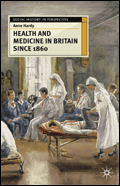Author's Abstract
Health and Medicine in Britain since 1860
ISBN: 033360010X - Hardback
ISBN: 0333600118 - Paperback
The 1860s were a critical decade in Britain's health history. Ravaged by successive waves of infectious disease - of typhus, measles, scarlet fever, cholera, smallpox, and wound infections in the hospitals - the country seemed to many observers to be under siege by epidemics. Tuberculosis was still the leading cause of death, and medicine seemed powerless either to control or to cure these and many other disorders. Average life expectancy was just over 40 years, and in many towns and cities much less. Yet this decade also saw the emergence of new medical knowledge and techniques that marked the beginning of slow but significant change in the powers of medicine to heal, to alleviate physical illness and to control disease. By the end of the decade the introduction of anaesthesia and changing practices in the operating theatre began a transformation in surgery; and research in bacteriology and physiology opened new perspectives on ways of tackling disease. Although the medical benefits of this research were long term rather than immediate, they took place within a context in which public health activity - such as measures against infectious diseases, the improvement of public water supplies, and the implementation of mains drainage - were also beginning to make an impact on patterns of death and disease.
By 1900, another ten years had been added to life expectancy, and some of the major infectious killers were fast disappearing. In the twentieth century, more especially after 1920, modern medicine began to roll. Two world wars tested the relationship between health and medicine both among the fighting forces and among civilians at home: the the First World war, medicine contributed significantly to the eventual military success; in the Second World War, it played a key role in sustaining the war effort on the home front. With the discovery of the antibiotics during World War II came an unprecedented therapeutic revolution which, after 1945, transformed medicine's ability to alleviate and to cure a great many ills of body and mind. Before long, popular expectations of what medicine could achieve had begun to change, and medical shortcomings were beginning to be challenged. Although by 2000 life expectancy was over 75 years, and the acute infectious diseases had disappeared as life-threatening scourges, medicine was being increasingly called to account.
The transformation in health experience which is reflected in rising life expectancy and changing disease patterns, and the contribution which modernising medicine has made to that transformation, are examined in this book. Five chapters give a chronological account of these developments. The first considers how and why health experiences changed between 1860 and 1914, and assesses how medicine may have influenced health despite its then limited curative powers. Chapter 2 looks at the ways in which medicine contributed to sustaining the war effort in World War I, and at the effects on civilian health of the diversion of medical manpower to the battlefields. Chapter 3 discusses the ups and downs of the interwar years - the impact of unemployment and depression, as well as the gradual emergence of new treatments and medical techniques which improved the prospects for patients with certain conditions. Chapter 4 examines the medical management of World War II on the civilian front and its consequences for both health and medicine. Chapter 5, finally, explores the brave new world of the post-antibiotic era, in which medicine's dramatically increased ability cure and to control disease generated new popular attitudes towards the discipline and its practitioners.

